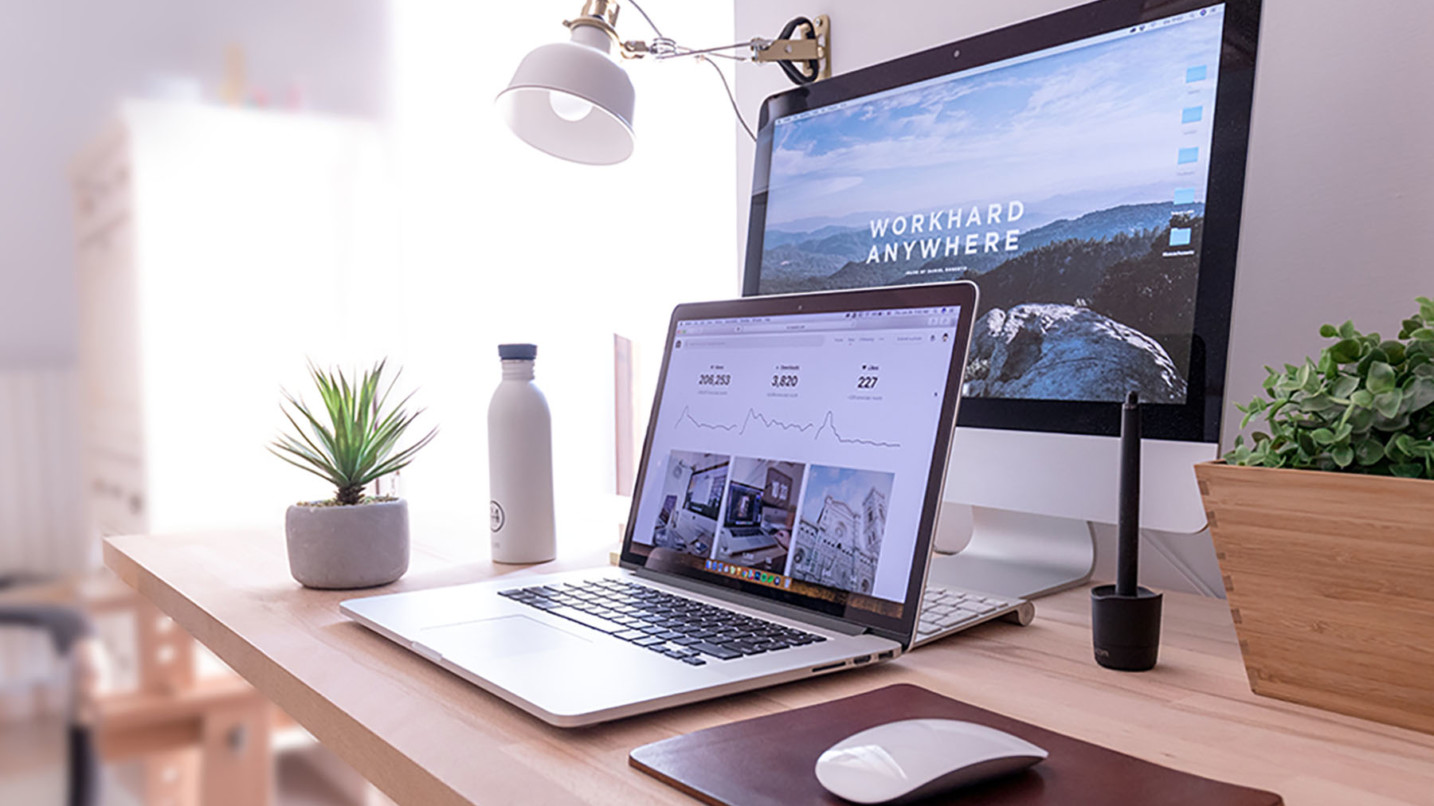
Transitioning into a freelance or remote work-from-home position?
This is a guide to surviving and thriving in a home office.
Multiple times in my career, I’ve worked from home. After many mistakes over the years, I finally figured out how to get work done and still live a normal life. I put together this list of to-do’s and not to-do’s based on my experience, while debunking many of the other work from home articles I’ve read.

As someone having worked in the creative industry for over a decade, I’ve worked in every type of environment. I have worked on set, lived the cubicle life (driving a beige sedan, ugh), worked in an open-plan office, inside a theater tech booth, and now I am in my element, working remotely from home.
If you have the fortune to transfer into a full-time freelance career or remote position, there are upsides and downsides. I’m going to offer some advice and tips I’ve learned on working from home.
(Author’s Note: If you are early in your career, working during the day and freelancing evenings, some tips, like scheduling, won’t apply to your situation right now, but there is still plenty more to take away.)
1. “No Pants Freelance” is a huge mistake
Going back to the first time I worked as a freelancer after college, I worked from home. As a recent graduate, I thought I had the world figured out and knew everything about production. Obviously, I was ignorant and made a ton of mistakes. That said, those mistakes did lead me here.
Perhaps the most harmful decision I made in those early years was the embrace of the “No Pants Freelance” lifestyle. I took it literally, often only working in a t-shirt and underwear. Hey, I never saw clients, why get dressed? Well, turns out that was a terrible decision.
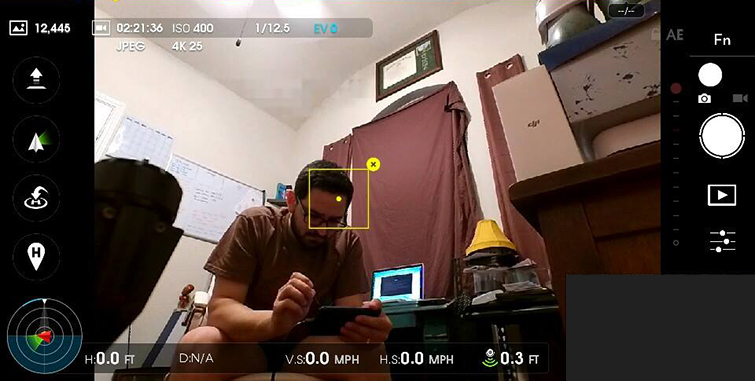
Proof of no pants from test footage.
Not only does your personal hygiene suffer, your mental clarity will too. Over days, weeks, and months, I became a shell of a human. Depression and anxiety start to take over, and before you know it, you’re a complete mess both in and out of work. This was precisely what I wanted to avoid this time.
I’ve now built a morning routine, which I’ll get to shortly, but the culmination is getting dressed for work. I put on pants everyday. Pants. Not shorts, not pajama pants, but a pair of pants. I’ll wear a button down shirt or t-shirt each day, but the pants are essential. This is my brain telling my body that I am going to work.
Perhaps the best piece of advice I’ve ever received, “put on shoes.” It may seem like such an insignificant thing, but it makes a world of difference. Putting on shoes is literally and figuratively the last step you make to enter work mode. Now you’re ready to go to work.
2. Set a schedule and routine
So, you found that you may have escaped an intense and rigorous corporate 8-5 schedule. That’s a good and bad thing. Structure exists for a reason, but it’s not hard for things to become too structured. I find that this is the optimal time window to get work done. It’s also when everyone else is working.
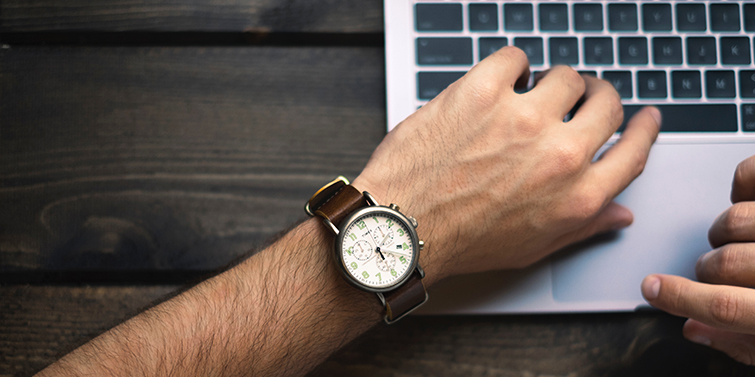
Now, the real 8-5 was the first thing I abandoned. It doesn’t make sense when you work from home. 8-5 was designed for corporate jobs with mandated hour long lunch breaks. At home, you don’t need an hour lunch every day. Most days, I’ll run to the kitchen, make a simple meal, eat, and go back to work. Usually in about 15 – 20 minutes. (Bonus: eating lunch at home is a good way to save money too.)
I now work 9-5 everyday. It’s a dedicated time slot, but I’m not too strict about it. I may come in at 8:45, I may come in at 9:30, but around 9 AM is when I start each workday. That’s because I find that to be the hour I’ve already mentally prepared for. I also shut down most days at 5 PM, but if I am in the zone I may work into the night. I do my best to stop before it’s time for dinner with the family. I put all my effort into the day to avoid working nights, but on rare occasions it will still happen.
Having dedicated work hours allows you to live a life outside of work. This is often the hardest struggle for creatives and freelancers.
Knowing my start time, I know that I’ll need to wake up earlier, try to get some exercise in, shower, make coffee and breakfast, get dressed, then get to work by 9. Don’t roll out of bed at 8:59 and go to work 9. Give yourself time to mentally prepare. Otherwise you’ll lose your first hours mindlessly scrolling through feeds and sites getting distracted for hours at a time.
3. Build an office and prioritize purchases
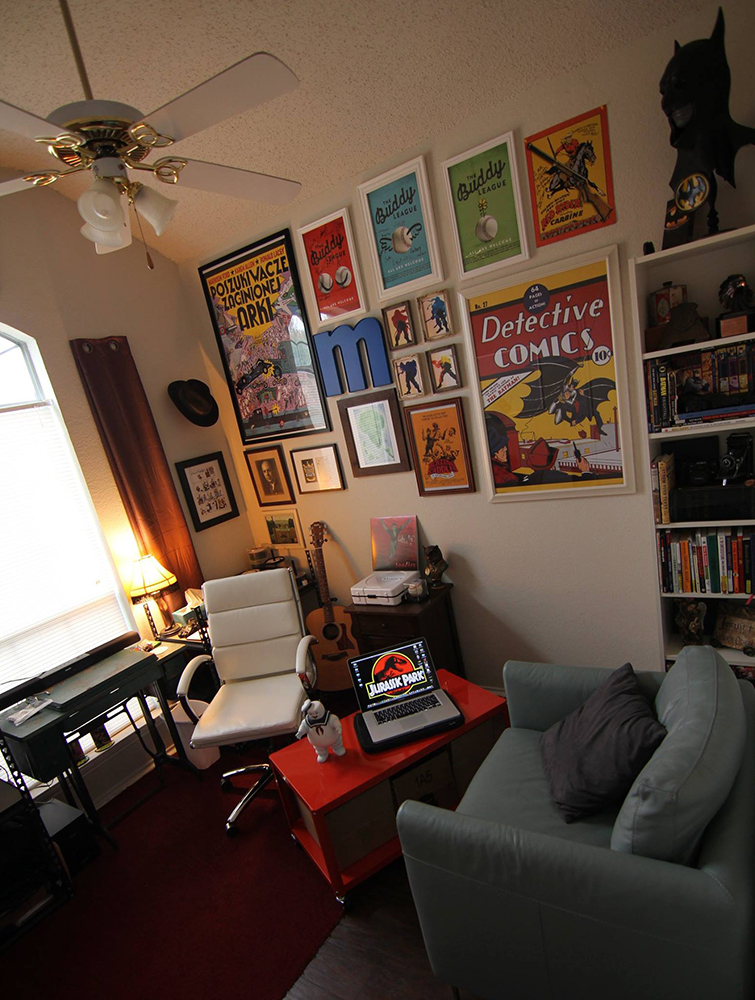
My first home office. Note that the desk is an old sewing table, I was broke.
The worst advice I’ve read about working from home was immediately spending thousands of dollars remodeling your work space. DO NOT DO THIS! It is terrible advice. Don’t fall for those Pinterest and Instagram lifestyle lies. You don’t need a knock-off fancy chair that will still cost hundreds of dollars that you’ll never sit in.
Everyone reading this will prioritize things based on their own budgets, lifestyle, and desires. I want to start by saying that not everything in this section is crucial to your success, but over time certain luxuries will make things easier.
If you have the space in your home, have a dedicated office with a door. I’m in a converted guest room. Having a door is important, a closed door means you are at work and in a separate place from home. I avoid coming into my office during non-work hours, and my family knows that if the door is closed I am not to be disturbed.
You want to avoid common areas. Working at a dining room table is not only uncomfortable, you’ll have to move all your stuff when it comes time to eat. Also, being out and about in the home means you’re likely to get distracted by unimportant things like dirty dishes or dusty furniture.

Current setup, cropping out as much mess as possible.
My first purchase in my current office was my desk. In the past I worked at makeshift tables, for two years I cut video on an old sewing table because I was broke, and that’s all I had. I don’t have a luxurious desk, just a simple IKEA Alex. It’s sturdy, has drawers, easy cable management, and it’s affordable. I also chose grey because it’s not Beigescalegorilla.
Pretty much everything else I already had, but here are some suggestions to prioritize.
Things worth buying immediately:
- Desk
- Comfortable chair
- Work computer
- Over-the-ear headphones
- Quality internet speeds
- Battery backup and surge protector
- Notepads, pens, basic supplies
That’s really all you need to get to work. A comfortable chair will save you from a life of pain, fast internet makes things easier, and a battery backup is crucial to everyone working on a computer.
On the topic of computers, try to have a dedicated work computer. I know this isn’t possible for everyone, but as soon as you start streaming movies and shows on your work machine, you won’t take it seriously. Have a work station used only for work, and leave the browsing and streaming to a laptop, tablet, or phone. When you’re always at your work machine, you’ll find yourself messing around during the day, and checking emails and working all night. I don’t know why that happens, but it just does.
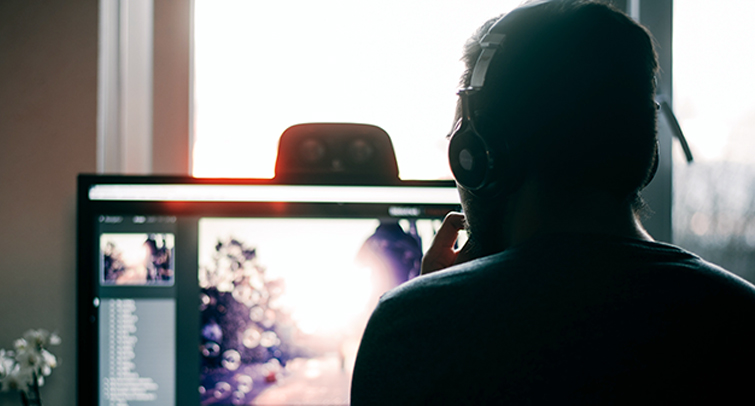
I also highly suggest investing in studio quality over-the-ear headphones. Not only is the sound quality exceptional, but they also drown out noise from the rest of the house. If you’re curious, every pair of headphones I have owned cost more than the desk I’m sitting at. That’s how important they are. If you are looking for recommendations, these are all under $200.
- Audio Technica ATH-M50x (personal favorite)
- Sony MDR-7506 or MDR-V6
- beyerdynamic DT 770 PRO
- Sennheiser HD 280 PRO
- AKG 240
If you’re doing heavy renders, it’s probably pretty hot. So get some fans to get some air circulation going around. As for everything else, you can get as needs arise. You’ll likely want to get a file cabinet or shelves to store paperwork and references, then another chair if you even decide to have guests or clients. I have an old mini-fridge that I use to keep some drinks and healthy snacks. This is a great way to keep me from wandering into the kitchen every hour just to open the fridge and stare at it, never grabbing anything.
All my artwork and decor are things I’ve accrued over the years. I like to have some colors around me, so I have a series of posters, collectibles, and toys. I didn’t blow the budget I set aside by buying anything unnecessary.
Luxuries to get over time:
- File cabinet
- Shelving
- Fan(s)
- Chair or couch for yourself and guests
- Mini-fridge
- Art and decor
- Plants
4. Leaving the house
At some point during the day, make time to leave the house. Even if it’s just for a couple of minutes. It’s refreshing to see what other human beings look like and have fresh air in your lungs. I personally have two things I do to leave the office.

I try to start everyday outside. I hate running, but I find myself mentally clear after a run or bike ride. Even if you just go for a walk around your neighborhood or apartment complex, that little bit of sun in the morning will make a difference. I’ve slid into phases without exercise and my depression and anxiety will always start to creep in after a few days. Be physically active in any way.
I also realize that my people skills suffer when I don’t get out often. I set aside a day to work away from the house, either at a coffee shop or library. It may be for a morning, or even the whole day. I know this isn’t always possible depending on the type of work you are doing, but you can set this aside as time to handle emails, make your invoices, or write a blog post.
5. Talk to fellow creators
Perhaps one of the most challenging aspects of working alone, you don’t have easy access to feedback or just general artist collaboration. Studios and agencies thrive on creative teams, because they all feed off of each other. When you work alone from home, it’s hard to get criticism or praise.

The Futur, School of Motion, and Greyscalegorilla at the 2018 NAB Mograph Meetup via Chad Ashley.
There’s no easy way to change this, but there small things you can do to keep your creative juices flowing. Depending on the city you live, you may find that there are local meetups. Greyscalegorilla actually sponsors several C4D meetups all over the world, including Chicago, Dallas, Seattle, Denver, Las Vegas, and London. Just do a search for a C4D meetup near you.
There are also dedicated online communities. The Cinema 4D subreddit, GSG Connect Slack channel, CG Society forums, and more. You can even join in on monthly projects like 5-Second Projects or challenges in the C4D subreddit.
6. More helpful advice for freelancers
I wanted to share a couple of other resources for you to listen to, including the GSG Podcast episode Tips for Working Remotely.

Jumpstart Your Cinema 4D Journey
Learn and Work from home
Your All-Access Pass to the Training You Need
Join Plus